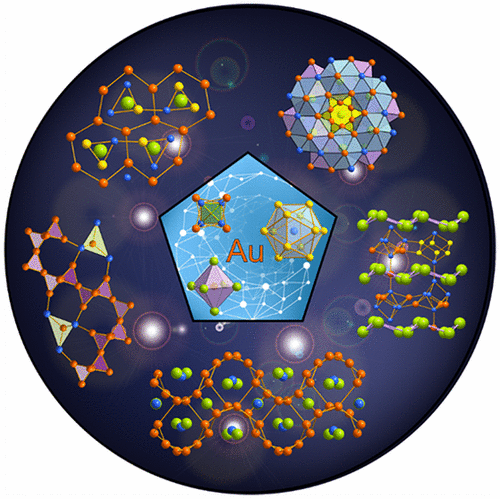当前位置:
X-MOL 学术
›
Acc. Chem. Res.
›
论文详情
Our official English website, www.x-mol.net, welcomes your feedback! (Note: you will need to create a separate account there.)
Gold Polar Intermetallics: Structural Versatility through Exclusive Bonding Motifs
Accounts of Chemical Research ( IF 18.3 ) Pub Date : 2017-11-07 00:00:00 , DOI: 10.1021/acs.accounts.7b00316 Volodymyr Smetana 1, 2 , Melissa Rhodehouse 1, 3 , Gerd Meyer 1, 3 , Anja-Verena Mudring 1, 2, 4
Accounts of Chemical Research ( IF 18.3 ) Pub Date : 2017-11-07 00:00:00 , DOI: 10.1021/acs.accounts.7b00316 Volodymyr Smetana 1, 2 , Melissa Rhodehouse 1, 3 , Gerd Meyer 1, 3 , Anja-Verena Mudring 1, 2, 4
Affiliation

|
The design of new materials with desired chemical and physical characteristics requires thorough understanding of the underlying composition–structure–property relationships and the experimental possibility of their modification through the controlled involvement of new components. From this point of view, intermetallic phases, a class of compounds formed by two or more metals, present an endless field of combinations that produce several chemical compound classes ranging from simple alloys to true ionic compounds. Polar intermetallics (PICs) belong to the class that is electronically situated in the middle, between Hume–Rothery phases and Zintl compounds and possessing e/a (valence electron per atom) values around 2. In contrast to the latter, where logical rules of formation and classification systems were developed decades ago, polar intermetallics remain a dark horse with a huge diversity of crystal structures but unclear mechanisms of their formation. Partial incorporation of structural and bonding features from both nonpolar and Zintl compounds is commonly observed here. A decent number of PICs can be described in terms of complex metallic alloys (CMAs) following the Hume–Rothery electron-counting schemes but exhibit electronic structure changes that cannot be explained by the latter. Our research is aimed at the discovery and synthesis of new polar intermetallic compounds, their structural characterization, and investigation of their properties in line with the analysis of the principles connecting all of these components. Understanding of the basic structural tendencies is one of the most anticipated outcomes of this analysis, and systematization of the available knowledge is the initial and most important step.
中文翻译:

金极性金属间化合物:通过独家结合母题的结构多功能性
具有所需化学和物理特性的新材料的设计,需要对潜在的组成,结构,性质之间的关系以及通过控制新组分的参与对其改性的实验可能性进行透彻的了解。从这个角度来看,金属间相是由两种或多种金属形成的一类化合物,呈现出无穷无尽的组合场,这些组合会产生从简单合金到真正的离子化合物的数种化学化合物。极性金属间化合物(PIC)属于电子类别,位于休ume-罗西相和Zintl化合物之间的中间,且具有e / a(每个原子的价电子)约为2。与后者形成逻辑和分类系统的逻辑规则相反,极性金属间化合物仍然是一匹黑马,其晶体结构种类繁多,但形成机理尚不清楚,而后者是数十年前发展起来的逻辑规则。在此通常观察到非极性和Zintl化合物都部分结合了结构和键合特征。遵循休ume-热电子计数方案,可以用复杂的金属合金(CMA)来描述一定数量的PIC,但是它们显示出的电子结构变化无法用后者来解释。我们的研究旨在发现和合成新的极性金属间化合物,它们的结构特征,并根据连接所有这些组成部分的原理进行分析来研究它们的特性。对基本结构趋势的理解是此分析最可预期的结果之一,而可用知识的系统化是最重要的初始步骤。
更新日期:2017-11-07
中文翻译:

金极性金属间化合物:通过独家结合母题的结构多功能性
具有所需化学和物理特性的新材料的设计,需要对潜在的组成,结构,性质之间的关系以及通过控制新组分的参与对其改性的实验可能性进行透彻的了解。从这个角度来看,金属间相是由两种或多种金属形成的一类化合物,呈现出无穷无尽的组合场,这些组合会产生从简单合金到真正的离子化合物的数种化学化合物。极性金属间化合物(PIC)属于电子类别,位于休ume-罗西相和Zintl化合物之间的中间,且具有e / a(每个原子的价电子)约为2。与后者形成逻辑和分类系统的逻辑规则相反,极性金属间化合物仍然是一匹黑马,其晶体结构种类繁多,但形成机理尚不清楚,而后者是数十年前发展起来的逻辑规则。在此通常观察到非极性和Zintl化合物都部分结合了结构和键合特征。遵循休ume-热电子计数方案,可以用复杂的金属合金(CMA)来描述一定数量的PIC,但是它们显示出的电子结构变化无法用后者来解释。我们的研究旨在发现和合成新的极性金属间化合物,它们的结构特征,并根据连接所有这些组成部分的原理进行分析来研究它们的特性。对基本结构趋势的理解是此分析最可预期的结果之一,而可用知识的系统化是最重要的初始步骤。



























 京公网安备 11010802027423号
京公网安备 11010802027423号